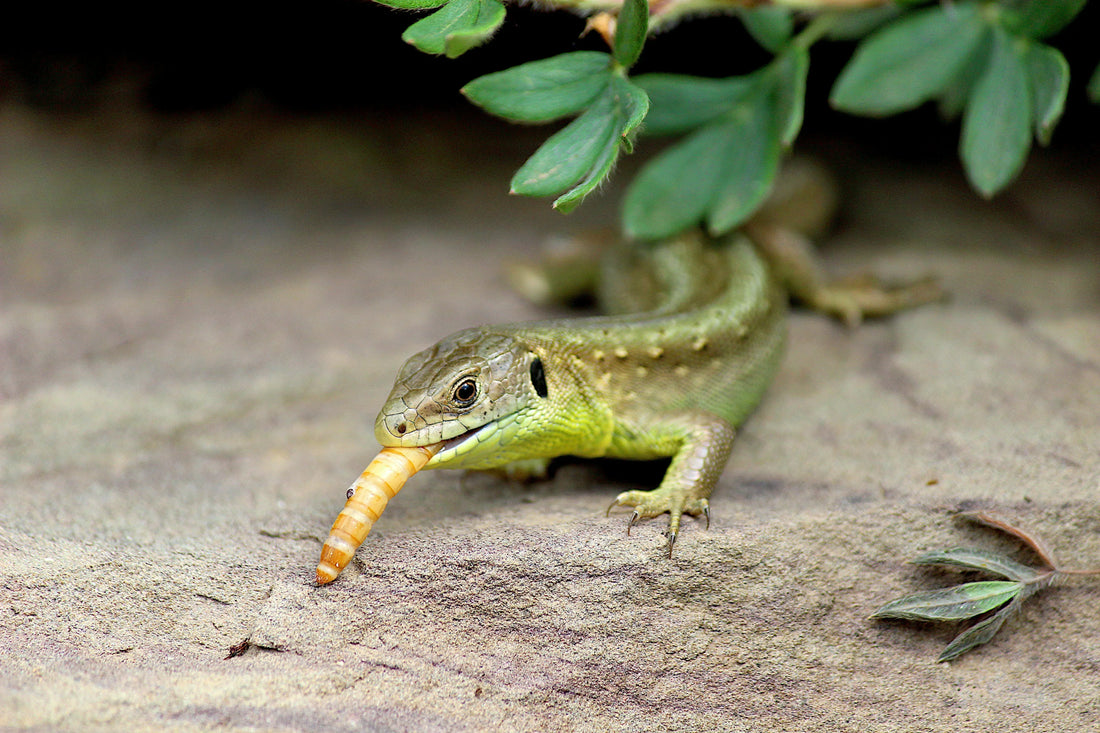
Why Feed Homegrown Mealworms to Reptiles: Nutrition & Enrichment
Share
Benefits of homegrown mealworms for reptiles
This blog will discuss live mealworms as a food source for reptiles that require insect protein in their diets. The benefits of growing your own mealworms for your reptile will be explored. Lastly, the reptile classifications and those that may require insects as a food source will be listed.

Some reptiles must have insects as their only or main food source. These obligate insectivores have evolved to get all their nutritional requirements from insects alone. Others need nutrients from insects at varying levels. Some are more omnivorous and can fulfill their dietary needs from other sources but still benefit from the nutritional and behavioral enrichment feeding live mealworms provides.
In captivity, nutritional deficiencies can easily arise if the feeder insects are of poor nutritional quality or if there is not enough variety in the diet. Regardless of species, one thing wild reptiles share is dietary variety. Studies on wild populations show them feeding on a wide range of seasonally available foods—whether they are insectivores, herbivores, omnivores, or carnivores. This should be replicated as much as possible in captivity to support balanced nutrition.
Nutritionally dense
Mealworms, especially when properly fed, are a good source of protein and minerals. They are higher in fats than some other feeder insects—fat is essential for energy and tissue development. However, it’s important to monitor feeding amounts, especially for inactive reptiles, as overfeeding can lead to health issues. Like most feeder insects, mealworms are low in calcium. Dusting or gut loading (feeding mealworms calcium-rich foods before feeding them to your reptile) helps avoid deficiencies.

Mealworms are by far the easiest of the feeder insects to raise yourself...
Mealworms require minimal care and space. Raising them yourself saves money and gives you control over their nutritional quality—from egg to beetle. This ensures that your reptile is getting a consistent and healthy food source.
Live food is essential for many reptiles, not just for nutrition but also enrichment. Many reptiles respond only to live, moving prey. Producing your own mealworms leads to healthier, more active feeder insects than those bought in stores, which often travel long distances and lack proper care. Home-raised worms also allow size selection—important for species like leopard geckos that prefer smaller mealworms.

It's not possible to cover all reptile species here, as Reptilia includes tens of thousands of animals with different dietary needs. The amount of insect protein needed varies significantly across species.
There are a few different classification schemes in herpetology, but the four orders widely recognized are:
Chelonia: This includes turtles and terrapins (e.g., red-eared sliders, painted turtles, map turtles). Many are omnivorous and can benefit from mealworms. While most tortoises are herbivores, a few like the red-footed tortoise require some animal protein, which insects like mealworms can provide.
Rhynchocephalia: This order includes only one species—the Tuatara. It’s endangered and highly protected, so while not directly relevant here, its taxonomy is worth noting.
Squamata: The largest order, covering lizards and snakes. Their diets vary greatly. Leopard geckos can eat mealworms regularly; bearded dragons can have them as a treat or enrichment food. Blue-tongued skinks may include them as part of their insect-based intake. While most snakes feed on vertebrates, a few, like rough green snakes, occasionally consume insects like mealworms.
Crocodilia: Includes crocodiles, alligators, and caimans. These are not typical pets and require a fully carnivorous diet. Although hatchling caimans may eat invertebrates, this is a highly specialized area not covered in depth here.
